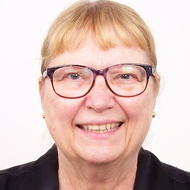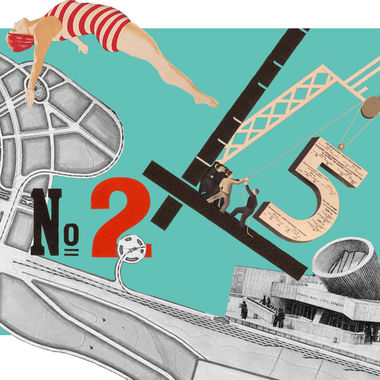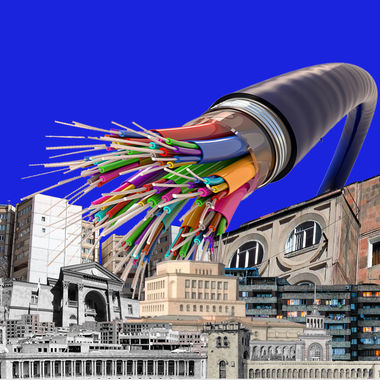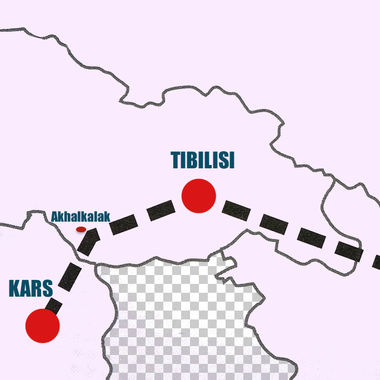
One of the major challenges of any society in the world today is the development and management of its transportation. Not only does transportation enable mobility, it also supports socialization by bringing people together. If poorly managed, transportation generates significant problems and high costs. This challenge is faced by Armenia and, much like elsewhere in the world, it is compounded by an overdependence on the car. But is the existing transportation systems effective and efficient for serving Armenia’s people?
This article aims to examine this question and propose a possible path forward to achieve more equitable access to mobility, and the revitalization of Armenian transport for a sustainable future. The hope is that positive change can be achieved by identifying some of the strengths of the current transport system, which partially relies on Soviet era legacy, suggesting creative alternatives that could replace costly personal transport, and identifying opportunities for new infrastructure development. While we are witnessing new developments both on a small scale and large scale in Armenia’s transportation sector, a more comprehensive and integrated approach may be needed to ensure sustainability.
Areas for change that are discussed in this article can be implemented on a limited basis to begin with and eventually expanded. Even with limited resources, progressive, incremental improvements can take place. The key to this change may also rest on public education and awareness, combined with creative, innovative solutions, as well as political will and leadership.
Anyone driving a car and trying to find a parking spot in the capital city of Yerevan is confronted with too many other cars vying for the city’s limited space, resulting in too much time wasted sitting in traffic while adding to the city’s already high pollution levels. Let’s not forget the risks of collisions on overcrowded streets and the danger to pedestrians, not to mention the added stress of noise pollution. Crowded, older, polluting buses offer little consolation. Healthier, more efficient and safer alternatives are needed.
read part one here
Reimagining Armenia: Economic Development and Creative Industries Proposal
By Lucyann Kerry
In the first of a series of articles, Dr. Lucyann Kerry proposes ways to reconfigure, reconnect and reconstruct the flow of resources, money/capital and human agency/interaction to revitalize the country based on successful models.
It is worth noting that there is also a strong relationship between the lack of access to transportation and the incidence of poverty. Greater access to transportation has the potential to improve the lives of economically disadvantaged people, whether they live in cities or rural areas. Because housing is cheaper in the outlying areas of cities, those who are forced to live there incur higher transport costs to reach jobs in the central district or elsewhere in the city, further impoverishing these households.
Think Smart, Think Creatively
For economic development purposes, Armenia has serious transport constraints, especially when it comes to trade. Armenia is a landlocked country, with geopolitical relationships that limit cross-border transport. This is especially evident with the closed borders of Turkey and Azerbaijan. Nevertheless, being landlocked without direct access to ports and sea trade, comes with other choices as well as opportunities for the use of internal and external resources. Thus, Armenia is challenged to think smart and to think creatively. Switzerland has proved to be one of the most successful landlocked countries in the world. Its economy thrives on services such as banking and export of high value goods, but also a significant tourism sector, that is supported by an efficient public transport system.
When it comes to improving Armenia’s transport system, a core issue may be the need for greater community involvement and better communication among key stakeholders in order to build a consensus for change. Does Armenia have the will to do this? Such change has been undertaken in many parts of the world. According to Juan Cole, writer and researcher at the University of Michigan, 75 percent of Scotland’s electricity is now green, primarily from wind but also solar and hydro renewable energy. As a result of shifting over to a more sustainable energy base, all cars in Scotland will be electric by 2032. Another example of small populations making significant progress toward innovative transport solutions is the Vauban neighborhood of Freiburg in southern Germany. Hailed as a model of sustainability, the community used cooperative decision-making to achieve eco-friendly living. With most of its inhabitants not owning cars, they created an interconnected transportation system dependent on walking, cycling and public transport. Cars are parked on the outskirts and are not allowed inside the community. Moreover, as recently reported in The Guardian, the small, landlocked country of Luxembourg, faced with some of the worst traffic in the world, plans to offer free public transport beginning in 2020. It is the first country in the world to do this. Many cities such as Tallinn, Estonia have already taken this measure to improve their transportation systems and quality of life.
Luxembourg also has something that Armenia could easily develop with its more limited resources. This is effective access to transport information that includes integrated timetables of all public transport. The Mobility Centre, an online portal, makes it easier for public transport users to look for information on routes, timetables and fares. The communication of transport information distributed through various channels, both digital and non-digital media could improve the use of existing transportation in Armenia. It would support tourism development if it also included multilingual translations. The identification of transport stops could be improved through new branded signage with multi-lingual translation. Making transport communication more effective for a range of users, including business travelers and tourists, may be one of the easiest and least costly ways for Armenia to improve its transportation systems.
Fadiah Achmadi, a sustainable transport specialist, who writes for the Environmental Center for Arab Towns based in Dubai, explains that Europe provides best practice examples for sustainable transportation. Transport policy is developed based on a conceptualization where “activities are centred around the main public transport stations to promote the use of public transport, mixed spatial use (living, working and leisure area) in order to reduce mobility demand, high quality public transport in the city with an excellent travel information system, car free city centre in order to promote cycling and walking and to increase livability of city centres, and strong parking regulations in the city to reduce car traffic.” Could this provide a map for revitalizing Yerevan?
If there is one unsustainable transportation system in the world, it is that of the U.S. with its heavy dependence on gas guzzling cars, which are a major cause for climate change. Yet, there is one city in the U.S. where residents do not have driver’s licenses and do not need to own cars. It is New York City, one of the oldest, and largest cities of the U.S. NYC is pedestrian friendly, with a city center that is walkable and offers alternative choices for transport, including the largest subway in the world in terms of number of stops. Its network of interconnected transport includes rail service, airports, water ferries, shipping and passenger port facilities, buses, taxis, pedicabs, horse drawn carriages and a sky tramway. As a result of this exceptional difference in transport, New York City is one of the most energy efficient cities in the U.S.
As other countries set examples and move forward to solve transport problems, Armenia may have an opportunity to use its energized political will and seek innovative solutions to its transport system. This is an exciting time for re-imagining transportation. One of the best examples in the world where imagination and creativity have been brought to life is Masdar City, a newly built community in the United Arab Emirates, a three to four-hour flight from Yerevan. The transportation strategy of this new community supports walking as an important mode of transport along with sustainable and energy efficient public transportation. Being built on flat open land and using substantial financial resources, Masdar City sets a high bar for being emulated by the city of Yerevan, but it does provide an inspiring example for having a vision and turning it into reality.
Thus, Armenia may need to identify where its advantages exist, especially with its specific topography and wisely use its limited resources to reap the greatest advantage for its transport system A key resource for public transport in Armenia and the capital city is the infrastructure and operations of Yerevan’s city subway.
also read
The Uncomfortable Truth About the State of Armenia’s Telecommunications
By Justin Tomczyk
Whether its a minor disruption due to a mechanical issue or a major blackout from conflict in the region, it is only a matter of time before another Internet outage hits Armenia. Policymakers should address this issue and consider a variety of policy options.
Opening of the Akhalkalak-Kars Railway: What to do Now?
By Vahram Ter-Matevosyan
On October 30, 2017 the Baku-Tbilisi-Kars Railway better known as the Akhalkalak-Kars Railway, became operational. The Akhalkalak Terminal, is only 30 kilometers from Armenia’s border. What does this mean for Armenia and for the Armenians of Javakhk? Vahram Ter Matevosyan takes a closer look at the implications and prospects for Armenia.
Rail Lines
Karen Demirchyan Yerevan Subway - An Underutilized Public Transport Resource
The Yerevan metro system consists of ten stations and is owned by the government with oversight through the Ministry of Transport and Communication. It has close to 42,000 daily ridership. Its advantages include a low cost fare, a commitment to safety, frequent timing of cars, and stations located in key places. However, Yerevan metro’s stations do not have extensive reach or access for the entire urban area and its population. Though line extensions have been planned, they have not been constructed yet. Daily use ranges from crowded cars at times to almost empty cars at other times; the existing stations themselves are run down, some with empty interiors, others with small businesses and commerce. The existing subway system could be better integrated into a new or re-formed system and leveraged to drive economic change.
The Inter-connectivity of Rail, Road and Trade
There are two major types of national transportation systems that could have significant impact on boosting Armenia’s economy if conditions were right: rail, and roads and highways. Not only do they provide mobility for passengers, they are significant for commerce and trade, and both are influenced by geopolitical concerns and relationships.
Rail
Henning Schwarz, Head of Unit Sustainable Development, International Union of Railways (UIC) makes a case for the advantages of rail in the current transport context, when he explains, “The explosion in global mobility has created environmental challenges. Transport accounts for over 50% of world consumption of fossil fuels – forecast to increase to 60% in 2035. Within transport rail accounts for 2% of CO2 emissions.” In other words, rail transport could contribute to fighting against global warming and could be the backbone of a sustainable transport system. It operates on electricity and diesel fuels but could use alternative fuels such as biogas and natural gas. Furthermore, it is understood to be a safe transport, moving freight and people, and at the same time providing jobs.
Rail has tremendous potential for Armenian society if it is managed well. Even though the development of the rail system faces certain constraints, some progress has already been made. This month, South Caucasus Railways is introducing a new electric train for providing regular rail service between Gyumri and Yerevan. It is a new second-generation EP2D electric train manufactured by Russia. The new trains will run four times a day and the duration of the trip is 2 hours and 10 minutes.
Until 2008, the Armenian government owned its national rail system, Armenian Railways, but sold operating rights to Russian Railways as a joint-stock company South Caucasus Railway (SCR). In essence, the government of Russia owns the national train system of Armenia under a thirty-year concession agreement. At question is whether the rail transport system under its current concession can realize its full potential as a national carrier for the transport needs of Armenians, especially if compared to train services in European cities as a benchmark. Although the Armenian rail system is, in effect, a transport legacy from the Soviet system, it could possibly be improved in the future. Rail transport is used not only for moving goods and passengers internally, but also for trans-border trade and passenger service into Georgia. The use of Armenia’s rail as transport for freight into Georgia is directly related to Armenia’s membership in the Eurasian Economic Union (EEU) and its relationship with Russia. Rail and trade are entwined and entangled in these relationships.
Trade Routes
The Eurasian Economic Union (EAEU or EEU)
The EEU is a treaty-based economic union for single market trade among its members. In 2014, Armenia joined the union, which also includes Russia, Kazakhstan, Belarus and Kyrgyzstan. Not having physical borders with the other member states, Armenia’s rail transport is an important enabler for the country to take advantage of free trade within the Union via shipping access through Georgia.
It should be noted that there are questions about how effective EEU membership is for Armenia and whether, overall, membership benefits are advantageous or disadvantageous in economic terms for its member states. However, EEU membership has been identified as significant for Armenia’s stability in the energy market for gas importation and serves as an added reinforcement of the Russia – Armenia special relationship for national security. Nevertheless, trade and transport may be redefined and reconfigured in the future because of the geopolitical relationships of the region with China.
The New Silk Road – Armenia’s North-South Highway Development and China
The very identity and values of a culture, place or people may be represented through associations with transportation. The bullet trains of Japan, the Tube of London, the yellow taxi cab of New York City, the Paris Metro, the bicycles of Amsterdam and the gondolas of Venice communicate much more than mobility. In the past the Romans were famous for the Appian Way, and in this region there was the famous Silk Road. Armenia was a major player along this historic route, as a linkage in the economic trade between East and West. This trade route was displaced with global ocean transport after Magellan’s voyage in 1519.
But this trade route may still play a significant role in Armenia’s future. China is seeking to expand its global influence and dominance with a new Silk Road known as The Belt and Road Initiative. It is a new trade route that follows the historical Silk Road but also includes added reach into Asia and Africa as a vast connective trade network. It is also China’s strategy for infrastructure development and investments. EEU constraints could be disadvantageous for Armenia in terms of this new global trade initiative. As an EEU member, Armenia is unable to negotiate bilateral free trade agreements. However, if the Eurasian Union negotiates an economic agreement with China, then Armenia would be part of the agreement.
A potential part of this new trade route connectivity is Armenia’s North-South Highway, the 556 km-long Meghri-Yerevan-Bavra highway. It is a major US$1.5 billion infrastructure highway project funded by the Asian Development Bank (ADB), European Investment Bank (EIB) and Eurasian Development Bank (EDB). When complete, the highway will provide access to European countries via the Black Sea. It could also eventually interconnect the Black Sea ports of Georgia and the four ports of Iran. The ports of Iran could provide access to new trade markets of the United Arab Emirates, India, Pakistan and Asia.
To further enhance the benefits of this project for Armenia, a new rail link, the 305 km long Southern Armenia Railway in southern Syunik has been proposed. It could create the shortest transportation route from the ports of Georgia to the ports in Iran. In addition, it could enhance access for Iranian tourists into Armenia and grow this segment of the tourism market. However, the status of this project is not clear and it may have been shelved.
Air Transportation
Armenia’s Commercial Aviation - Zvartnots International Airport and Shirak Airport
If there is a bright light in the transportation landscape of Armenia, it is its air transport sector and its developing aviation resources. This transport area may be one of the most critical in determining Armenia’s future economic development and sustainability.
With two international airports in Armenia, Zvartnots International Airport and Shirak International Airport, Zvartnots serves as a crown jewel for gateway access into the country. In 2001, a 30-year concession agreement for the management of operations at the airport was signed with Armenia International Airports CJSC, which is owned by Armenian Argentine businessman Eduardo Eurnekian. This appears to have been an advantageous arrangement for airport upgrade and improvements. It also appears that as a result of this management leadership, the airport has been designated "Best Airport In the CIS" by the aviation industry.
Passenger traffic through Armenia’s airports has been steadily increasing to almost 3 million a year, with most of this growth at Zvartnots. Shirak International Airport serves the second largest city in Armenia, Gyumri. Despite service being limited only to and from Russia, it has still experienced high rates of growth. In comparison, Zvartnots Airport is serviced by a wide range of airlines such as Fly Dubai/Emirates, Qatar, Air France, Aeroflot Russia that provide service to Europe, Russia, the Middle East and elsewhere Although there are air cargo operations, the economic advantage for aviation transport may be its use as a tourism gateway. Currently Russians are the major percentage of tourists coming to Armenia and the tourism market could expand in other directions due to the reach of the country’s air services.
Although Armenia once had a national airline, Armenian Airlines, it had gone bankrupt by 2003. There are, however, new developments and growth in this transport sector. There is a new Armenia branded airlines, Armenia Aircompany , founded in 2015 as a commercially owned airline. It consists of a two airline fleet and services Georgia, Russia and Israel. In addition, a commercial light aviation company, Atlantis Armenian Airlines, plans to begin scheduled flights in the summer 2019. It has announced it will operate flights from Zvartnots to destinations in Europe and the CIS as well as charter flights to the Greek islands. It also plans to operate domestic flights from Zvartnots to the Kapan Airport in Syunik, Armenia and other regional destinations. Moreover, Armenian Helicopters, a Yerevan-based start-up, is set to become Armenia’s first commercial helicopter operator.
Aerial Tramways, Aerial Railways and Mountain Railways – Creative Transport
Aerial tramways are a specific type of transport using vehicle suspension on cables. They are used in hilly or mountainous areas. They have a range of different names depending on their cable configuration and whether they go around corners or not. In looking for innovative ways to re-invigorate and re-imagine transportation specific to Armenia’s terrain and topography, this form of transport may offer solutions. Originating in Switzerland, aerial tramways move people between two or more locations and may use different energy sources for motion such as diesel and electricity.
New York City may provide a successful example as a model for Yerevan. It uses skyway public transport with its Roosevelt Island Tramway. The tramway is the first commuter aerial tramway in North America and is used for transport across the East River to the Roosevelt Island community. Two cabins hanging from cables carry 125 passengers each and a ride provides views of the city’s skyline. Its use may expand further as a result of the shutdown of one of the city’s subway lines. The successful use of this type of transport in the city of Medellin, Colombia as a public transport aerial tram led to its adoption by other South American countries.
In Armenia, The Wings of Tatev provides transport in a non-urban, rural setting between Halidzor and the Tatev monastery. It is the world’s longest non-stop double track cable car, and supports community development and tourism. Proposal for Action
In the transport described above, there are areas where existing resources can be improved and successful infrastructure developed further. There are also problematic areas that need a substantive re-think and re-design. This article has only focused on selective areas and is not all-encompassing. It did not examine bus transport as urban public and private transport or transport inrural areas.
At the beginning of 2018, the government began developing a plan for a ‘unified transport route network.’ In doing so, it included 50 communities into the existing inter-regional routes. However, the development and planning was focused on a traditional approach, favoring passenger vehicles as a national transport network. As such, there is a further need for new models and paradigms.
The following are proposed as recommendations to move toward sustainable transportation and create positive change in order to improve the quality of life for the people of Armenia. It is not intended to be comprehensive, but rather aims to identify key aspects that could be used to approach issues of transportation. A key component in the proposal is to conceptualize, plan and create specialized hubs i.e. a new Government Hub, the International Airport Transport Hub and a Yerevan City Center Hub, and define or create new linkages and interconnectedness as the basis for an innovative, sustainable transport system.
Recommendations and Goals
Recommendation 1: Create a New National Transportation System that includes the Revitalization of the Existing Public Transportation System
This would consist of a range of sustainable transport choices interconnected through a Central Transport Hub Near Yerevan as a national gateway, as well as being a city transport hub. This gateway would be directly linked to Zvartnots International Airport, as the country’s International Transport Gateway Hub, as well as the new community Government Hub. Each of these hubs would provide points of access and inter-connectedness between the main links and peripheral hubs via a number of different sustainable transport choices, including current infrastructure such as Yerevan’s Central Train Station and Metro stations.
This development could be understood as a Transport Renovation Initiative. It should be based on community stakeholder participation and transportation research studies for identifying needs and opportunities for change. This recommendation includes the following goals:
Goal 1: Conduct a “Comprehensive and Extensive Transportation Needs Assessment for Societal Well Being” – This is a systematic process to identify transport needs and improvements of current conditions with stakeholders and communities for planning and policy development. It may include: assessment for the establishment of extensions or new lines of transport to serve underserviced areas, especially those overly dependent on vehicular transport outside of Yerevan; a needs assessment for smaller gauge rail; the identification of interconnection hubs where buses, trains and a new rail link could cross with taxi service, cycling paths and pedestrian walkways; an assessment of alternative energy sources for transport; and a study of the viability of a government subsidized internal shipping system - a low cost national express or parcel service to support small to medium businesses - which be paid for through increased taxation or other revenue streams.
Sub-Goal 1) Stakeholder and community participation through a range of events, workshops, meetings and other forms of involvement for voicing concerns, opinions and sharing information.
Sub-Goal 2) Establish Key Goals and Priorities for Action
Goal 2: Conduct a “Feasibility Study of How to Accomplish Sustainable Transport Goals and Action” with an analysis of areas such as technology, energy use, organization and financing.
Sub-Goal 1) Establish a process for policy development and adoption
Sub-Goal 2) Produce a plan of action to address transport needs, accomplish goals and implement actions
Goal 3: Design, develop and produce small scale demonstration/model projects for sustainable urban and rural Transport
Goal 4: Develop a public service campaign initiative to raise awareness about the issues and needs of sustainable transportation
Goal 5: Develop and implement branding and signage for the transportation system
Goal 6: Develop and conduct a transportation education initiative targeting different levels of education from primary to adult, including a safe driving campaign. This goal of Educate for Sustainable Transport could lead to a human resource workforce with high-end skills that could be offered for consulting services globally.
Recommendation 2: Establish a New Rail linkage (possibly an Elevated Monorail or Aerial Tram) for the Zvartnots Airport Gateway Hub to interconnect with the National Transport System, its Transport Hub, the new Government Hub and the Yerevan City Center Hub
At the heart of the revitalization is the train link from the Airport to the new hubs. This could help relieve urban congestion and provide new access to alternative living and working.It could be modeled on the monorail systems of Kuala Lumpur, Tokyo, or Helsinki and would be integrated with the other hubs as an airport link.
Recommendation 3: Redesign the city transport system of Yerevan and create a multimodal system that is pedestrian focused with a car free center and sustainable transport.
This would be designed after researching the flow, use and transport needs of residents. The multimodal system would allow commuters to use more than one mode of transportation per journey with mini-transport hubs. For example, someone might choose to ride a bus to the nearest train station, then take the train to their destination. This system provides greater travel flexibility and helps solve the “first-mile, last-mile” problem. It would include a range of choices with expansion for non-carbon fuel transport i.e. bicycles with bike paths. If bicycle use expanded, there would be a need for small level bicycle repair stations.
There could be an integrated transport with riverside development using aerial trams for travel along the river and walkway bridges across the river. A monorail loop around the city based on the monorail systems of Kuala Lumpur, Tokyo and Helsinki and Disneyland could be built.
Incentives could be introduced to encourage public transport use – including a transit card for all forms of public transport that is connected to a loyalty program with the possibility to use points earnt for purchases in stores and restaurants or attendance to museums and other cultural events.
Hop on and hop off buses, trolleys, ‘trams without tracks’ with designated stops could be introduced; a circular tram around the city perimeter could be constructed.
Bicycle paths could be built on accessible land. Single person transport paths could be developed for skateboards, segways, roller blades, etc. as the car in your bag concept.
Smaller transport pods could be constructed in pedestrian areas as interconnection points with other transport choices for public bicycles, adult tricycles, pedicabs, motorized TukTuks. Smaller scale, multiple underground parking and underground street bypasses could be built to support diverse transport providing added jobs in the economy.
This transport recommendation includes the revitalization of Yerevan’s Metro with possibly free public transport in the city center and, turning the existing Metro stations into multi-function social activity and government ‘One Stop’ centers, in part modeled after the post offices of Finland as libraries, social activity spots and coffee houses.
It also includes the recommendation for a New Centralized Bus Terminal, integrating city transport with transport for areas outside of Yerevan and interconnecting the services of busses, mini-buses (Marshrutkas) and taxis. As part of a re-design of the city’s transport, a city owned or operated taxi service could operate from this terminal with a branded City Taxi licensing and metered fares.






